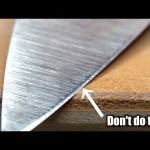Do you have a dull knife that needs sharpening but don’t have a sharpener? Don’t worry, you can still sharpen your knife without a sharpener. In this article, we will provide a step-by-step guide on how to sharpen your knife without a sharpener. We will discuss the different methods you can use to sharpen your knife, the materials you will need, and the safety precautions you should take. With this guide, you will be able to sharpen your knife without a sharpener in no time.
Can you sharpen a knife without a sharpener
Sharpening a knife is an important part of knife maintenance. It is important to keep your knives sharp to ensure they are safe and effective to use. But what if you don’t have a sharpener? Is it possible to sharpen a knife without one?
The answer is yes, you can sharpen a knife without a sharpener. There are several methods you can use to sharpen a knife without a sharpener. These methods include using a honing steel, a whetstone, a ceramic plate, or even a piece of sandpaper.
Honing Steel – A honing steel is a long metal rod with a handle. It is used to realign the blade of a knife and remove any burrs or nicks. To use a honing steel, hold the handle in one hand and the blade in the other. Place the blade against the honing steel at a 20-degree angle and draw the blade down the length of the steel. Repeat this process several times on each side of the blade.
Whetstone – A whetstone is a flat stone used to sharpen knives. To use a whetstone, soak it in water for 10 minutes. Place the blade of the knife on the stone at a 20-degree angle and draw the blade down the length of the stone. Repeat this process several times on each side of the blade.
Ceramic Plate – A ceramic plate is a flat plate made of ceramic material. To use a ceramic plate, place the blade of the knife on the plate at a 20-degree angle and draw the blade down the length of the plate. Repeat this process several times on each side of the blade.
Sandpaper – Sandpaper can also be used to sharpen a knife. To use sandpaper, place the blade of the knife on the sandpaper at a 20-degree angle and draw the blade down the length of the sandpaper. Repeat this process several times on each side of the blade.
These are just a few of the methods you can use to sharpen a knife without a sharpener. With a little practice and patience, you can keep your knives sharp and in good condition without the need for a sharpener.
How do you sharpen a knife step by step
Sharpening a knife is an important skill to have in the kitchen. It is essential for keeping your knives in good condition and ensuring that they are safe to use. Here are the steps to follow when sharpening a knife:
Step 1: Gather the Necessary Materials
Before you begin sharpening your knife, you will need to gather the necessary materials. You will need a sharpening stone, a honing steel, a cloth, and some lubricant. The sharpening stone is used to grind away the dull edges of the blade, while the honing steel is used to realign the blade’s edge. The cloth is used to wipe away any debris, and the lubricant is used to keep the blade from becoming too hot.
Step 2: Prepare the Knife
Once you have gathered the necessary materials, you will need to prepare the knife. Start by wiping the blade with the cloth to remove any debris. Then, apply a few drops of lubricant to the blade. This will help to keep the blade from becoming too hot during the sharpening process.
Step 3: Sharpen the Knife
Now it is time to sharpen the knife. Start by placing the sharpening stone on a flat surface. Hold the knife at a 20-degree angle and begin to move the blade across the stone in a circular motion. Make sure to keep the angle consistent throughout the process. After a few passes, you should begin to see a burr forming on the blade. This is an indication that the blade is being sharpened.
Step 4: Hone the Knife
Once the blade has been sharpened, it is time to hone the knife. Start by placing the honing steel on a flat surface. Hold the knife at a 20-degree angle and begin to move the blade across the steel in a circular motion. Make sure to keep the angle consistent throughout the process. After a few passes, you should begin to see a burr forming on the blade. This is an indication that the blade is being honed.
Step 5: Clean and Store the Knife
Once you have finished sharpening and honing the knife, it is time to clean and store it. Start by wiping the blade with the cloth to remove any debris. Then, apply a few drops of lubricant to the blade. This will help to keep the blade from becoming too hot during storage. Finally, store the knife in a safe place, such as a knife block or a drawer.
Sharpening a knife is an important skill to have in the kitchen. By following these steps, you can ensure that your knives are always in good condition and safe to use. So, the next time you need to sharpen a knife, just follow these steps and you will be good to go!
What are the 3 methods of sharpening knives
Knives are essential tools in the kitchen, and keeping them sharp is important for safety and efficiency. There are three main methods of sharpening knives: honing, sharpening, and stropping.
Honing
Honing is the process of realigning the microscopic teeth of the blade. This is done with a honing steel, which is a rod made of steel or ceramic. The honing steel should be held at a 20-degree angle to the blade and drawn along the length of the blade in a sweeping motion. This should be done on both sides of the blade.
Sharpening
Sharpening is the process of removing metal from the blade to create a new edge. This is done with a sharpening stone, which is a flat stone made of diamond, ceramic, or water. The stone should be held at a 20-degree angle to the blade and drawn along the length of the blade in a sweeping motion. This should be done on both sides of the blade.
Stropping
Stropping is the process of polishing the blade to a razor-sharp edge. This is done with a leather strop, which is a strip of leather with a compound on one side. The strop should be held at a 20-degree angle to the blade and drawn along the length of the blade in a sweeping motion. This should be done on both sides of the blade.
By honing, sharpening, and stropping your knives regularly, you can keep them in top condition and ensure that they are safe and efficient to use.
How do you sharpen a kitchen knife for beginners
Sharpening a kitchen knife is an important skill for any home cook. A sharp knife is safer and more efficient to use than a dull one. Fortunately, sharpening a kitchen knife is not difficult and can be done with a few simple tools. Here are some tips for beginners on how to sharpen a kitchen knife.
Gather the Right Tools
The first step in sharpening a kitchen knife is to gather the right tools. You will need a sharpening stone, a honing steel, and a cloth. A sharpening stone is a flat stone with a rough surface that is used to grind away metal from the blade. A honing steel is a rod-shaped tool that is used to realign the blade’s edge. A cloth is used to clean the blade after sharpening.
Prepare the Knife
Before sharpening the knife, it is important to prepare it. Start by cleaning the blade with a cloth. Then, secure the blade in a vice or clamp to keep it steady while sharpening. Make sure the blade is facing away from you and that your hands are out of the way.
Sharpen the Knife
Once the knife is prepared, it is time to sharpen it. Start by running the sharpening stone along the blade in a circular motion. Make sure to keep the stone at the same angle as the blade. Move the stone from the base of the blade to the tip. Do this several times on each side of the blade. After sharpening, use the honing steel to realign the blade’s edge. Finally, clean the blade with a cloth.
Maintain the Knife
Sharpening a kitchen knife is not a one-time task. To keep the blade sharp, it is important to maintain it. After each use, clean the blade with a cloth and use the honing steel to realign the blade’s edge. It is also a good idea to sharpen the blade with a sharpening stone every few months.
Conclusion
Sharpening a kitchen knife is an important skill for any home cook. With the right tools and a bit of practice, anyone can learn how to sharpen a kitchen knife. Remember to clean the blade after each use and sharpen it with a sharpening stone every few months to keep the blade sharp.
We hope this guide has been helpful in teaching you how to sharpen knives without a sharpener. With a little practice and patience, you’ll be able to keep your knives sharp and ready for use. Goodbye and good luck!















